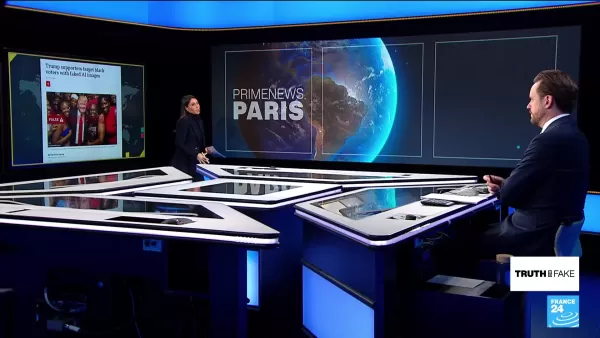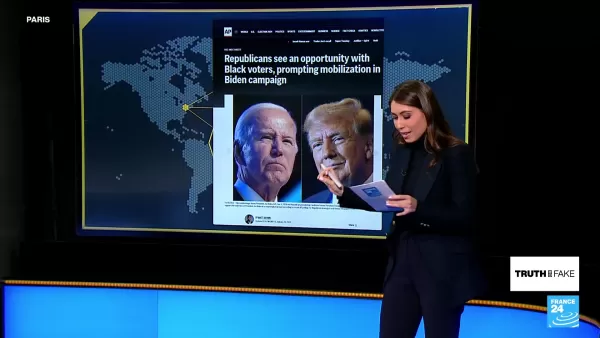AI Deepfakes and Political Misinformation: How to Identify Fake Content
The Deepfake Dilemma: How AI is Reshaping Truth in the Digital Age
We live in a world where seeing is no longer believing. With the rise of AI-generated deepfakes, the line between reality and digital fabrication has blurred—especially in politics. As we approach critical election cycles, these hyper-realistic forgeries are being weaponized to manipulate public opinion, often targeting vulnerable demographics.
But here’s the good news: you can fight back. By understanding how deepfakes work and learning to spot them, you can protect yourself—and others—from falling for sophisticated disinformation.
Why Deepfakes Are a Growing Threat
What Exactly Are AI Deepfakes?
Deepfakes are AI-generated images, videos, or audio clips that manipulate reality. Using advanced machine learning, scammers can make anyone appear to say or do things they never did. While the technology has legitimate uses (think movie dubbing or virtual assistants), its misuse in politics is alarming.
The 2024 Election: A Deepfake Battleground
As the U.S. election heats up, deepfakes are flooding social media. One disturbing trend? Fake AI-generated images of Black voters supporting Trump.

A BBC Panorama investigation uncovered dozens of these fabricated images, designed to sway Black voters. Some went viral, racking up 1.4 million views on X (formerly Twitter). One post falsely claimed Trump stopped his motorcade to take photos with young Black men—except the image was entirely AI-generated.

Why This Matters
Deepfakes don’t just spread lies—they erode trust in democracy. If voters can’t distinguish real news from AI-generated propaganda, elections could be decided by deception rather than facts.
How to Spot a Deepfake Before It Tricks You
AI isn’t perfect—yet. Most deepfakes still have subtle (or not-so-subtle) flaws. Here’s what to look for:
1. The "Hand Test"
AI struggles with hands. Look for:
- Extra or missing fingers
- Weirdly shaped hands
- Fingers merging into objects

Example: In one deepfake, Trump had only three fingers.
2. Unnatural Skin & Lighting
- Overly smooth or waxy skin
- Strange shadows or reflections
- Mismatched lighting on faces vs. backgrounds
3. Digital Glitches
- Blurry edges around faces
- Pixelation in unnatural places
- Odd color shifts on skin or clothing
Fact-Check Like a Pro: Don’t Fall for Fake News
Step 1: Verify the Source
- Who posted it? Check the account’s history—is it a bot or a real person?
- Is it from a trusted news outlet? If not, be skeptical.
Step 2: Reverse Image Search
- Use Google Lens or TinEye to see if the image appears elsewhere.
- If it’s only on obscure sites, it’s probably fake.
Step 3: Cross-Check with Reliable Fact-Checkers
- BBC Reality Check
- PolitiFact
- Snopes
Step 4: Watch for Emotional Manipulation
Deepfakes often play on fear, anger, or excitement. If a post makes you feel outraged, pause—it might be designed to manipulate you.
FAQs: Your Deepfake Questions Answered
Q: Can social media stop deepfakes?
A: Platforms are trying—using AI detectors and partnering with fact-checkers—but the battle is ongoing. Your best defense? Critical thinking.
Q: How can I protect myself?
A: Slow down before sharing. Verify, verify, verify. And teach others to do the same.
Q: Should AI be banned?
A: Not necessarily—but stronger regulations and ethical AI development are crucial to prevent misuse.
The Bottom Line
Deepfakes are here to stay, but you don’t have to be fooled. Stay vigilant, fact-check everything, and don’t let AI decide what you believe.
🚨 Think before you share. The truth depends on it.
Related article
 Google's Gemini app adds real-time AI video, Deep Research, and new features (120 chars)
Google unveiled significant Gemini AI enhancements during its I/O 2025 developer conference, expanding multimodal capabilities, introducing next-generation AI models, and strengthening ecosystem integrations across its product portfolio.Key Gemini Li
Google's Gemini app adds real-time AI video, Deep Research, and new features (120 chars)
Google unveiled significant Gemini AI enhancements during its I/O 2025 developer conference, expanding multimodal capabilities, introducing next-generation AI models, and strengthening ecosystem integrations across its product portfolio.Key Gemini Li
 Assort Health Secures $50M Funding to Automate Patient Communication
Assort Health, an emerging AI healthcare startup specializing in automated patient communications for specialty practices, has secured approximately $50 million in Series B funding at a $750 million valuation, according to sources familiar with the t
Assort Health Secures $50M Funding to Automate Patient Communication
Assort Health, an emerging AI healthcare startup specializing in automated patient communications for specialty practices, has secured approximately $50 million in Series B funding at a $750 million valuation, according to sources familiar with the t
 Generate Excel Formulas Instantly with AI-Powered Excel Tool
Transform your spreadsheet workflow with GPTExcel - the AI-powered solution that converts natural language descriptions into precise Excel and Google Sheets formulas. This powerful tool eliminates the frustration of manual formula creation, making co
Comments (1)
0/200
Generate Excel Formulas Instantly with AI-Powered Excel Tool
Transform your spreadsheet workflow with GPTExcel - the AI-powered solution that converts natural language descriptions into precise Excel and Google Sheets formulas. This powerful tool eliminates the frustration of manual formula creation, making co
Comments (1)
0/200
![AndrewPerez]() AndrewPerez
AndrewPerez
 September 3, 2025 at 8:30:33 PM EDT
September 3, 2025 at 8:30:33 PM EDT
政治人物現在連講話都要先證明自己是本人了嗎?😂 這些AI深偽技術真的讓選舉變成偵探遊戲了,以後投票前可能得先通過圖靈測試。


 0
0
The Deepfake Dilemma: How AI is Reshaping Truth in the Digital Age
We live in a world where seeing is no longer believing. With the rise of AI-generated deepfakes, the line between reality and digital fabrication has blurred—especially in politics. As we approach critical election cycles, these hyper-realistic forgeries are being weaponized to manipulate public opinion, often targeting vulnerable demographics.
But here’s the good news: you can fight back. By understanding how deepfakes work and learning to spot them, you can protect yourself—and others—from falling for sophisticated disinformation.
Why Deepfakes Are a Growing Threat
What Exactly Are AI Deepfakes?
Deepfakes are AI-generated images, videos, or audio clips that manipulate reality. Using advanced machine learning, scammers can make anyone appear to say or do things they never did. While the technology has legitimate uses (think movie dubbing or virtual assistants), its misuse in politics is alarming.
The 2024 Election: A Deepfake Battleground
As the U.S. election heats up, deepfakes are flooding social media. One disturbing trend? Fake AI-generated images of Black voters supporting Trump.

A BBC Panorama investigation uncovered dozens of these fabricated images, designed to sway Black voters. Some went viral, racking up 1.4 million views on X (formerly Twitter). One post falsely claimed Trump stopped his motorcade to take photos with young Black men—except the image was entirely AI-generated.

Why This Matters
Deepfakes don’t just spread lies—they erode trust in democracy. If voters can’t distinguish real news from AI-generated propaganda, elections could be decided by deception rather than facts.
How to Spot a Deepfake Before It Tricks You
AI isn’t perfect—yet. Most deepfakes still have subtle (or not-so-subtle) flaws. Here’s what to look for:
1. The "Hand Test"
AI struggles with hands. Look for:
- Extra or missing fingers
- Weirdly shaped hands
- Fingers merging into objects

Example: In one deepfake, Trump had only three fingers.
2. Unnatural Skin & Lighting
- Overly smooth or waxy skin
- Strange shadows or reflections
- Mismatched lighting on faces vs. backgrounds
3. Digital Glitches
- Blurry edges around faces
- Pixelation in unnatural places
- Odd color shifts on skin or clothing
Fact-Check Like a Pro: Don’t Fall for Fake News
Step 1: Verify the Source
- Who posted it? Check the account’s history—is it a bot or a real person?
- Is it from a trusted news outlet? If not, be skeptical.
Step 2: Reverse Image Search
- Use Google Lens or TinEye to see if the image appears elsewhere.
- If it’s only on obscure sites, it’s probably fake.
Step 3: Cross-Check with Reliable Fact-Checkers
- BBC Reality Check
- PolitiFact
- Snopes
Step 4: Watch for Emotional Manipulation
Deepfakes often play on fear, anger, or excitement. If a post makes you feel outraged, pause—it might be designed to manipulate you.
FAQs: Your Deepfake Questions Answered
Q: Can social media stop deepfakes?
A: Platforms are trying—using AI detectors and partnering with fact-checkers—but the battle is ongoing. Your best defense? Critical thinking.
Q: How can I protect myself?
A: Slow down before sharing. Verify, verify, verify. And teach others to do the same.
Q: Should AI be banned?
A: Not necessarily—but stronger regulations and ethical AI development are crucial to prevent misuse.
The Bottom Line
Deepfakes are here to stay, but you don’t have to be fooled. Stay vigilant, fact-check everything, and don’t let AI decide what you believe.
🚨 Think before you share. The truth depends on it.
 Assort Health Secures $50M Funding to Automate Patient Communication
Assort Health, an emerging AI healthcare startup specializing in automated patient communications for specialty practices, has secured approximately $50 million in Series B funding at a $750 million valuation, according to sources familiar with the t
Assort Health Secures $50M Funding to Automate Patient Communication
Assort Health, an emerging AI healthcare startup specializing in automated patient communications for specialty practices, has secured approximately $50 million in Series B funding at a $750 million valuation, according to sources familiar with the t
 Generate Excel Formulas Instantly with AI-Powered Excel Tool
Transform your spreadsheet workflow with GPTExcel - the AI-powered solution that converts natural language descriptions into precise Excel and Google Sheets formulas. This powerful tool eliminates the frustration of manual formula creation, making co
Generate Excel Formulas Instantly with AI-Powered Excel Tool
Transform your spreadsheet workflow with GPTExcel - the AI-powered solution that converts natural language descriptions into precise Excel and Google Sheets formulas. This powerful tool eliminates the frustration of manual formula creation, making co
 September 3, 2025 at 8:30:33 PM EDT
September 3, 2025 at 8:30:33 PM EDT
政治人物現在連講話都要先證明自己是本人了嗎?😂 這些AI深偽技術真的讓選舉變成偵探遊戲了,以後投票前可能得先通過圖靈測試。


 0
0





























